| Chinese
Recipes |
Dim
Sum or Small Snacks |
|
Chinese snacks are known the world
over as 'dim sum'. They are an integral part of
'Chinese Tea' which is called 'yeurm cha'. There
are literally thousands of these, and some western
versions may not be known on China Mainland. We
intend to explain what the popular ones are -
and as I am writing this, I will begin with my
personal favourites:
Let's Get
Started - Dim Sum |
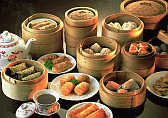 |
| |
Gao Zhi are crescent shaped and
a couple of inches long. They are the flash-fried
version of many similar dishes, and delicious
with a temperate chilli sauce for dipping - such
as chilli and garlic.
They are also vegetarian - which came as a surprise
to me, but apparently they cannot be eaten by
Buddhists because they contain garlic and water
chestnuts. Weird? |
| |
| Gao Zhi |
Ingredients:
• 50% chopped Chinese
mustard leaves, such as cheung
choi or similar. You could use spinach
as a western substitute, but this may be
too strong a flavour.
• 20%
Water Chestnuts cooked and chopped into
small chunks
• 10% garlic,
peeled and diced
• 10% fresh
ginger, very finely diced
• 5%
carrots finely diced
• 5%
Spring onions and/or shallots
• A
hint of salt and white pepper
For
the Wrappers: |
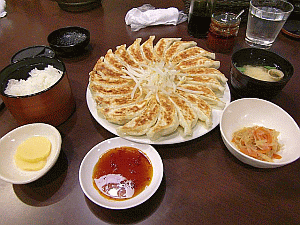 |
|
| Wheat flour pastry or Rice flour
pastry are both good, but for frying choose wheat
flour. For the non-fried versions use rice flour.
Buy these ready-made from the supermarket - they
should be similar in many respects to cheese slices
and ready to use - but should be round and about
four inches in diameter. They will probably be
somewhere in the freezer section of any good supermarket. |
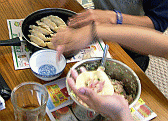 |
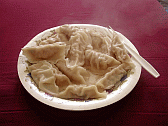 |
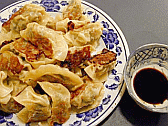 |
| |
Method:
To a mixing bowl add all the ingredients and stir
thoroughly so they become a slight paste. Take
a pastry round in one hand and add a generous
amount of the filling. Moisten the pastry rim
with water to make for a good seal. Fold over
and crimp the edges using thumb and fingers. You
would be best to nip the centre near the edge
first, and then work from one end to the other.
Ensure the seal is good and no filling is coming
out.
Cantonese chef's actually steam these first for
a couple of minutes to ensure the they are cooked
through. Shallow fry in a wok with oil on high
heat tossing continuously until golden brown.
|
|
|
| Steamed Gao Zhi |
These are very similar to above, but are
not fried. Therefore use rice pastry only. Sometimes
these are made the same size as above, and are virtually
identical except the mustard leaves are increased to
80%, and the other ingredients reduced accordingly,
with no garlic being simply left out. I'm not a fan
of these, but they remain popular.
|
| Siu Gao |
| These are smaller versions of above about
half the size and use waffer thin rice wrappers. They
come in many forms the most common of which are: Shrimps
with sweetcorn, Vegetarian Delight, and Ground Fish
Surprise. |
| |
| Apart from the ingredients, the rest
of the recipe is identical to above. To cook simply
put about nine on a small dish and steam in a wok for
up to 5-minutes. Serve to table with a suitable sauce
such as a mild chilli, soy sauce, plum or oyster sauce
- or whatever you prefer. |
| Shrimp Siu Zhi |
Vegetarian Delight |
Fish Surprise |
4 oz Shrimps or small Prawns
2 oz mustard leaves (Cheung Choi)
1 oz tinned sweetcorn
1 oz finely diced spring onions (Scallions)
1 oz mixed water chestnuts and carrots, diced into small
chunks
1/2 oz fresh ginger finely diced into 1 inch strips
1/2 oz finely diced garlic if you prefer?
Salt and Pepper to taste - not used by Cantonese chef's,
but we recommend a little of both.
1 Dozen Rice flour wrappers |
3 oz mustard leaves (Cheung Choi)
1 oz tinned sweetcorn
1 oz small chunks of mango or pineapple, or 1 oz of
both?
1 oz small chunks of sweet carrot
1 oz finely diced spring onions (Scallions)
1 oz mixed water chestnuts diced into small chunks
1/2 oz fresh ginger finely diced into 1 inch strips
1/2 oz finely diced garlic if you prefer?
Salt and Pepper to taste - not used by Cantonese chef's,
but we recommend a little of both.
1 Dozen Rice flour wrappers |
4 oz fish paté from the wet
market - ready mixed
Add flakes of fresh left-over fish if you have any?
2 oz mustard leaves (Cheung Choi)
1 oz finely diced spring onions (Scallions)
1 oz mixed water chestnuts diced into small chunks
1/2 oz fresh ginger finely diced into 1 inch strips
1/2 oz finely diced garlic if you prefer?
Salt and Pepper to taste
1/4 oz finely diced fresh coriander leaves
1 small drip Hoisin or fish sauce
1 Dozen Rice flour wrappers
When wrapping, place a small shrimp inside the paste
before closing
Replace above with a pickled shrimp, cockle or barnacle
for something entirely unusual and delicious = Chinese
usually marinade in sour soy sauce instead. |
| Siu Mai |
This entree is pretty standard all over
China, but varies considerably with establishments.
When you get good ones they are totally delicious! There
is also a chicken version.
They look like little bites with a deep yellow and circular
pasty encasing pork meat with fat, and prawns, and some
form of caviar sprinkled onto the exposed top - this
should actually be small red prawn eggs. |
|
Ingredients:
• 8
oz pork with fat
- just like good Butchers sausages
• 2
oz shrimps,
1oz chopped the other whole
• Prawn
eggs for dusting
• A packet of
wrappers - must be the deep yellow ones |
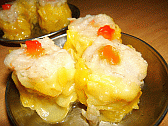 |
|
| Method |
Chop the meat and fat so that it has no
pieces bigger than 1/4 inch square with most being smaller.
I use pork loin for this in China, but you may find
pork shoulder better in the west. You need a mix of
about 70% meat to fat, which is one reason why I find
the pork loin so useful as the proportions are about
right and the fat is good and hard.
Put into a mixing bowl and add the shrimps, chopped
as necessary to the same size or less. The juice will
be enough to slightly bind the mixture. I would add
a hint of salt and pepper at this stage, but Chinese
chef's do not.
Prepare by taking the bought wrappers and folding into
the shape pictured. The diameter should be no greater
than 1 inch and they should be fractionally taller than
this. All should be the same size. The wrappers are
about 3 inches across and made specially for this dish.
Fill with the mixture and ensure one shrimp is placed
whole on top. Often another prawn/shrimp is added inside.
Sprinkle with prawn eggs and place in a bamboo steaming
basket on a piece of paper. Greaseproof paper is best,
but this is not used in China.
Tip:
You will find it a lot easier to use a mold such as
a small sized strip light starter and crimp the sides
first before adding the filling.
Cooking
is very simple. Place basket in a wok or saucepan with
spacer and add water for steaming. Cover and steam for
10 minutes maximum. The pork fat should turn translucent,
which tells you they are cooked through. Serve to table
in the bamboo basket with a side dish of sweet or tangy
chilli sauce. |
| |
English Lesson:
Mold vs Mould
Mold means to
shape or form something, perhaps using a prefabrication.
It comes from the Latin modulus
Mould
means a discolouration or fungal infection and comes
from the Scandinavian original version of (Northern
English) mowlde
Some English speakers get these two words confused.
(Source: DicDotCom) |
|
| Min Bao -
or steamed rice breads |
|
Min Bao is a collective name meaning rice
bread in Cantonese. In Mandarin these may be known
as Bao Zhi. There are hundreds of versions of
these things, most of which are either full of
sugar, laced with sugar, or dipped in sugary dips.
This would be ok I guess if there were not plain
version, custard and lemon curd versions, mixed
nut versions, and some pork versions.
Advice:
You really want to know what the filling is before
you try these things! |
 |
|
| Street versions are round and come
in small and large sizes. My wife buys the large ones
pictured and eats the bread only - handing me the good
bit inside to which I add salt and black pepper. It
works for us, so don't knock it. |
Posh versions are sort-of rectangular
with a convex top like a very small loaf, and
have a smooth exterior + are either white or brown
+ there are wholemeal versions. These come with
a selection of dips, of which a very white and
bland lemon curd thingymagig is very popular.The
sweet Chinese Red Date dip is a lot better, if
still sweet enough.
I have never known Chinese people make these
at home, as they are sold everywhere in China
and the large pork filled ones cost Y1 RMB each.
|
 |
| If you want to make these at home
in UK or USA, then first you should be a competent
bread maker? Given you can make
bread, then you need to use rice flour to
make these, and the dough is made in the same
way as any other bread. |
To make them light add sparkling water to make
the dough, or add a little Bicarbonate of Soda
(Cooking Soda), or both. Leave to rest for 30
minutes whilst they at least double in size, and
three times is the goal.
Once the dough has risen enough, take a lump and
treat very delicately. If not serving plain, simply
prize open and insert the filling. For lemon curd
you may prefer to simply inject it into the centre
- which can be used as a feature = yellow marks
the spot. However, this may overflow, so don't
do it this way and add a drop to the outside once
the bun is completed.
|
 |
|
|
| Lightly mould the breads back into the desired shape securing the treat inside. Small breads can be a couple of inches in diameter, whilst larger types can reach 6 inches across. The important thing is that they are all the
same size, or that all of the same type are the same size and shape at least. |
|
Cooking
Place buns on some paper, and rice-paper is excellent.
These breads are steamed in a wok above water
using the spacer, and traditionally done using
a bamboo version of a 'Bain Marie'. They take
about 50 minutes to cook through and for the yeast
to finish working. You can leave them in a little
longer with no detrimental effects.
Many Chinese cheat by using a rice cooker as a
sort of pressure-cooker, but this is not advised
as the slight extra pressure limits the dough
rising and makes for a stodgier result. However,
it does reduce cooking time down to 15 minutes;
so if the dough was proved for a very long time,
this can be very useful. |
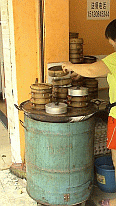 |
|
|
This is the beginning of
a very long page -
which in turn will become an new and seemingly endless
section.
Our plan is to separate out the larger recipes once
enough are in place, and create a reference page - so
a work in progress
Please call back later for more Dim Sum recipes and
Chinese culinary delights |
|
This information is as supplied by ourselves, and ably
supported by our friends and various internet portals. |